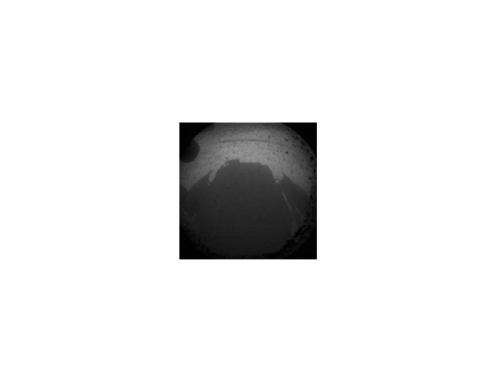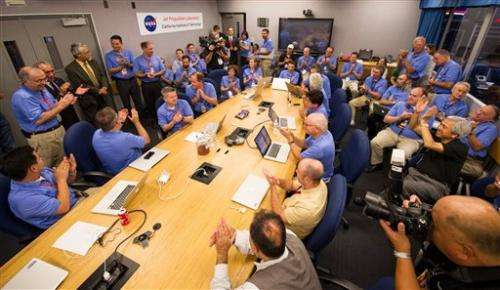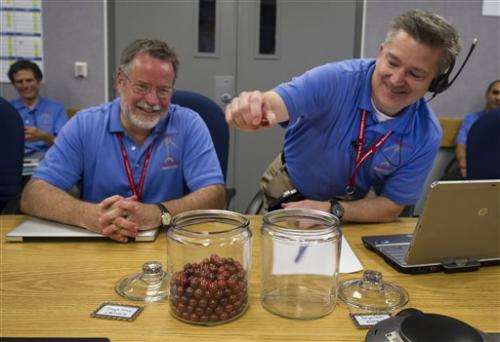NASA rover lands on Mars (Update 4)

NASA has successfully landed its $2.5 billion Mars Science Laboratory and Curiosity rover on the surface of the Red Planet, breaking new ground in US-led exploration of an alien world.
The one-ton rover is the largest ever sent to Mars, and its high-speed landing was the most daring to date, using a never before tested rocket-powered sky crane to lower the six-wheeled vehicle gently to the planet's surface.
"Touchdown confirmed," said a member of mission control at NASA's Jet Propulsion Laboratory as the room erupted in cheers late Sunday. "We are wheels down on Mars. Oh, my God."
A dusty image of the rover's wheel on the surface, taken from a rear camera on the vehicle, confirmed the arrival of the car-sized rover and its sophisticated toolkit designed to hunt for signs that life once existed there.
A second image arrived within seconds, showing the shadow of the rover on Mars. The official landing time was 10:32 pm Sunday on the US West Coast (0532 GMT Monday), according to a NASA statement.
The nuclear-powered rover is now set for a two-year mission to explore the Red Planet, including a long climb up a mountain to analyze sediment layers that are up to a billion years old.
When the landing was announced after a tense, seven-minute process known as entry, descent and landing, NASA's Jet Propulsion Laboratory filled with jubilation as the mission team cheered, exchanged hugs and chief scientists handed out Mars chocolate bars.
President Barack Obama described the feat as a singular source of American pride.
"The successful landing of Curiosity -- the most sophisticated roving laboratory ever to land on another planet -- marks an unprecedented feat of technology that will stand as a point of national pride far into the future," he said in a statement.
Charles Bolden, the NASA administrator, applauded all the nations who contributed to science experiments on board the rover.
"It is a huge day for the nation, it is a huge day for all of our partners who have something on Curiosity and it is a huge day for the American people," Bolden said.
Obama's science adviser John Holdren described the landing as "an enormous step forward in planetary exploration. Nobody has ever done anything like this."
"And if anybody has been harboring doubts about the status of US leadership in space, well there is a one-ton automobile sized piece of American ingenuity that is sitting on the surface of Mars right now," he added.
However, success was anything but certain. NASA's more recent rover dropoffs involved smaller craft that were cushioned with the help of airbags.
In the final moments, the MSL spacecraft accelerated with the pull of gravity as it neared Mars's atmosphere, making a fiery entry at a speed of 13,200 miles (21,240 kilometers) per hour and then slowing down with the help of a supersonic parachute.
After that, an elaborate sky crane powered by rocket blasters kicked in, and the rover was lowered down by nylon tethers, apparently landing upright on all six wheels.
Adam Steltzner, engineer and leader of the entry, descent and landing team, who has previously admitted the landing bid appeared "crazy," said that in the end, it "looked extremely clean."

"In my life, I am and will be forever satisfied if this is the greatest thing that I have ever given," he told reporters.
Scientists do not expect Curiosity to find aliens or living creatures. Rather, they hope to use it to analyze soil and rocks for signs that the building blocks of life are present and may have supported life in the past.
The project also aims to study the Martian environment to prepare for a possible human mission there in the coming years. Obama has vowed to send humans there by 2030.
The spacecraft has already been collecting data on radiation during its eight and a half month journey following launch in November 2011 from Cape Canaveral, Florida.
Previous attempts by global space agencies since 1960 have resulted in a near 40 percent success rate in sending landers, orbiters or other spacecraft for flybys to Mars.
NASA has the best record, with four prior mission successes to Mars: Viking 1 and 2 (1976), Pathfinder (1997), rovers Spirit and Opportunity (2004) and Phoenix (2008).
More than 1,000 spectators applauded at France's Toulouse Space Center as the Mars Science Laboratory and Curiosity rover landed on the Red Planet carrying two French-run components.
"It's a huge thrill after so much suspense," said Marc Pircher of France's CNES space research center. "Now the scientific adventure will begin."
The Toulouse Space Centre hosts the French Instrument Mars Operation Centre, which will manage two French instruments on Curiosity -- the ChemCam and the SAM-GC chromatograph.
The chemical camera will analyze rocks and soil to identify samples that would be of greatest interest to scientists for analysis by other instruments onboard, while the SAM-GC will sort, measure and identify gases for analysis.
"The ChemCam has been tested and it works. Now we know it is functioning on Mars," ChemCam deputy principal investigator Sylvestre Maurice told AFP.
Australian scientists at the Canberra Deep Space Communication Complex, which received the signals for the entry, descent and landing of the mission, also celebrated the "textbook" touchdown.
"When the signal came through... the place erupted. People were just over the moon... they were literally joyous," spokesman Glen Nagle said.
"For a lot of people who were too young to be around at the time of Apollo, this was their moon landing."

Key facts about NASA's Mars Science Laboratory
Here are some key facts about the mission of NASA's Mars Science Laboratory and Curiosity rover, the most sophisticated robotic vehicle ever built for planetary exploration.
MISSION: To study the Gale Crater near Mars's equator for signs that life may once have existed, and for clues about past and present habitable environments on the Red Planet. It is designed to function for 98 Earth weeks, or about one Martian year.
LAUNCH:
The mission launched from Cape Canaveral, Florida on November 26, 2011 atop a two-stage Atlas V 541 rocket by United Launch Alliance, a joint venture of Boeing and Lockheed. The journey to Mars has taken about 8.5 months, or 254 days.
LANDING:
"Seven minutes of terror" is a popular Internet video featuring top NASA scientists who describe the final touchdown scheduled for August 6 at 0531 GMT.
This is the first attempt of its kind to land a heavy vehicle on Mars by using a rocket-powered sky crane.
Entry, descent and landing begins when the spacecraft reaches the top of Mars's atmosphere, traveling at a speed of 13,200 miles per hour (5,900 meters per second).
Ten minutes before the spacecraft enters the atmosphere, it sheds its cruise stage, or the parts that carried propellant tanks and antennae to keep the spacecraft on course to Mars and enable communications.
It then goes through a period of peak heating as it enters the Mars atmosphere. A parachute is deployed, the heat shield separates and the rocket-powered sky crane deploys nylon cords to lower the rover to the surface.
Touchdown should occur at 1.7 miles per hour.
VEHICLE: A car-sized robotic rover with six wheels, nicknamed Curiosity. It weighs about one ton (900 kilograms) and cost $2.5 billion. The concept first emerged in 2000 and was developed at NASA's Jet Propulsion Laboratory in Pasadena, CA.
TOOLKIT: Ten instrument-based science investigations are on board:
1) Mast camera (MASTCAM) contains two megapixel color cameras that act as the left and right eye of the rover, and are capable of returning stills, video and 3D images.
2) Chemistry and Camera (CHEMCAM) is a rock-vaporizing laser and telescope combination that can target a rock 23 feet (seven meters) away, burn it and analyze the light that emerges to identify the chemical elements inside.
3) Alpha Particle X-Ray Spectrometer (APXS) is on the robotic arm and can identify chemical elements in rocks and soil.
4) Mars Hand Lens Imager (MAHLI) is a color camera on the end of the robotic arm for use in getting closeups of the ground or wider scenes of the landscape.
5) Chemistry and Mineralogy (CheMin) analyzes powdered rock and soils with X-ray diffraction.
6) Sample Analysis at Mars (SAM) has three tools to check for carbon-based compounds that are the building blocks for life, examine the chemical state of other elements important for life and search for clues about planetary changes.
7) Rover Environmental Monitoring Station (REMS) records daily and seasonal changes in the weather on Mars.
8) Radiation Assessment Detector (RAD) monitors high energy atomic and subatomic particles from the sun that could pose a danger to astronauts if a human mission to Mars ever occurs.
9) Dynamic Albedo of Neutrons (DAN) can detect underground water beneath the rover at a distance of 20 inches (50 centimeters).
10) Mars Descent Imager (MARDI) records full-color video of the final few minutes of the rover's descent onto the Martian surface. A few images are expected back within days of the landing, but the full video may take longer.
EXPLORATION SITE: Gale Crater, a 96-mile wide crater that contains a three-mile high mountain, shaped like a broad mound so the six-wheeled rover can climb at least halfway up the site.
Mars landing 'unprecedented feat of technology': Obama
US President Barack Obama hailed early Monday the successful landing of the Mars Science Laboratory and Curiosity rover on the surface of the Red Planet, calling it "an unprecedented feat of technology."
"The successful landing of Curiosity -- the most sophisticated roving laboratory ever to land on another planet -- marks an unprecedented feat of technology that will stand as a point of national pride far into the future," Obama said in a statement.
The comments came after the US space agency NASA successfully landed the $2.5-billion rover on the surface of Mars.
A dusty image of the rover's wheel on the surface, taken from a rear camera on the vehicle, confirmed the arrival of the car-sized probe and its sophisticated toolkit designed to hunt for signs that life once existed there.
A second image arrived within seconds, showing the shadow of the rover on Mars.
Obama said the United States "made history" with the achievement.
"It proves that even the longest of odds are no match for our unique blend of ingenuity and determination," he said.
"And tonight's success reminds us that our preeminence -- not just in space, but here on Earth -- depends on continuing to invest wisely in the innovation, technology, and basic research that has always made our economy the envy of the world."
(c) 2012 AFP





















